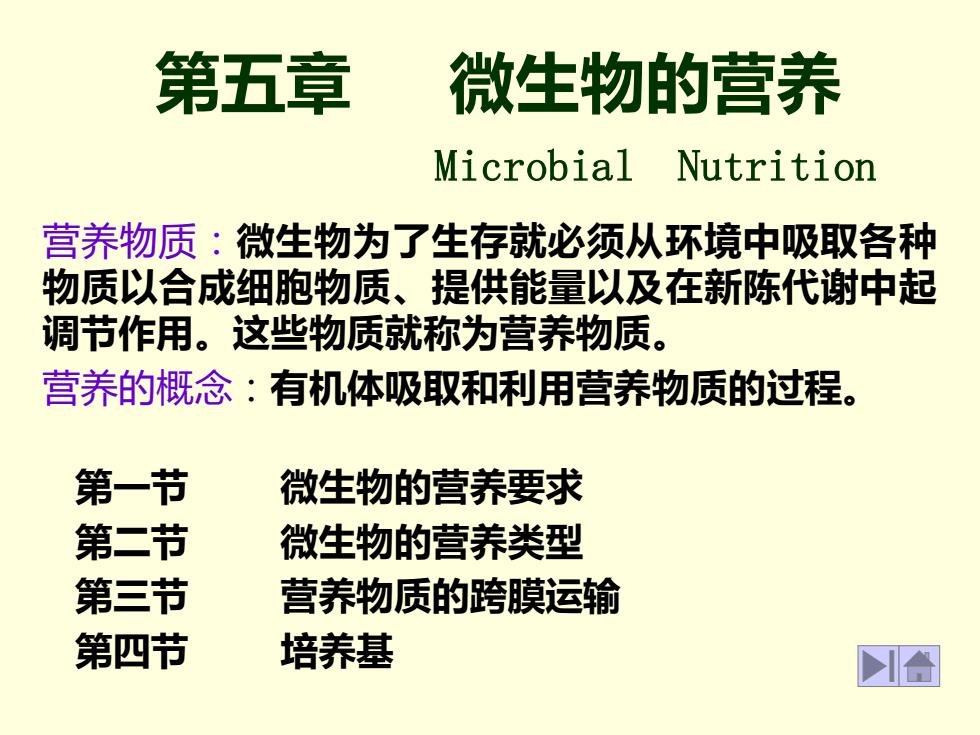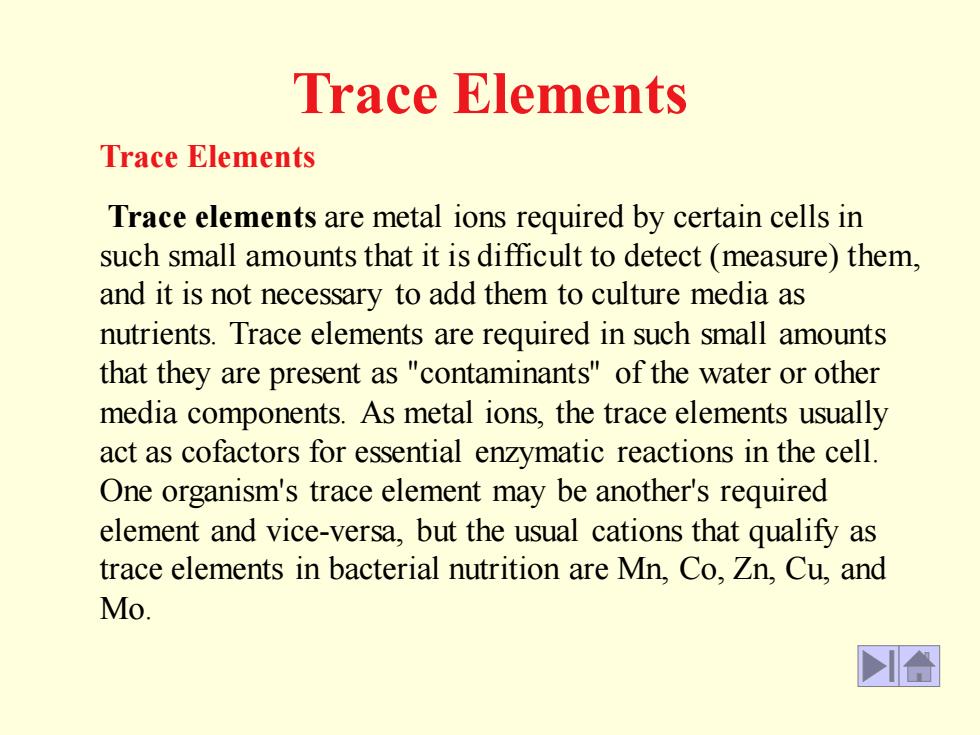
第五章 微生物的营养 营养物质:微生物为了生存就必须从环境中吸取各种 物质以合成细胞物质、提供能量以及在新陈代谢中起 调节作用。这些物质就称为营养物质。 营养的概念:有机体吸取和利用营养物质的过程。 第一节 微生物的营养要求 第二节 微生物的营养类型 第三节 营养物质的跨膜运输 第四节 培养基 Microbial Nutrition
第五章 微生物的营养 营养物质:微生物为了生存就必须从环境中吸取各种 物质以合成细胞物质、提供能量以及在新陈代谢中起 调节作用。这些物质就称为营养物质。 营养的概念:有机体吸取和利用营养物质的过程。 第一节 微生物的营养要求 第二节 微生物的营养类型 第三节 营养物质的跨膜运输 第四节 培养基 Microbial Nutrition

第一节 微生物的营养要求 一、微生物细胞的化学组成 二、营养物质及其生理功能 三、微生物的营养类型 Nutritional Requirements of Microbial Cells
第一节 微生物的营养要求 一、微生物细胞的化学组成 二、营养物质及其生理功能 三、微生物的营养类型 Nutritional Requirements of Microbial Cells

一、 微生物细胞的化学组成 (一)化学元素(chemical element): 大量元素(macroelement):碳、氢、氧、氮、 磷、 硫、钾、镁、钙、铁(其中前六种占细菌细胞干重的97%)。 微量元素(trace element): 锌、锰、钠、氯、钼、硒、钴、 铜、钨、镍 、硼。 元素 细菌 酵母菌 霉菌 碳 50 49.8 47.9 氮 15 12.4 5.2 氢 8 6.7 6.7 氧 20 31.1 40.2 磷 3 — — 硫 1 — — 表4—1 微生物细胞中几种主要元素的含量(干重%)
一、 微生物细胞的化学组成 (一)化学元素(chemical element): 大量元素(macroelement):碳、氢、氧、氮、 磷、 硫、钾、镁、钙、铁(其中前六种占细菌细胞干重的97%)。 微量元素(trace element): 锌、锰、钠、氯、钼、硒、钴、 铜、钨、镍 、硼。 元素 细菌 酵母菌 霉菌 碳 50 49.8 47.9 氮 15 12.4 5.2 氢 8 6.7 6.7 氧 20 31.1 40.2 磷 3 — — 硫 1 — — 表4—1 微生物细胞中几种主要元素的含量(干重%)

The Major Elements At an elementary level, the nutritional requirements of a bacterium such as E. coli are revealed by the cell's elemental composition, which consists of C, H, O, N, S. P, K, Mg, Fe, Ca, Mn, and traces of Zn, Co, Cu, and Mo. These elements are found in the form of water, inorganic ions, small molecules, and macromolecules which serve either a structural or functional role in the cells. The general physiological functions of the elements are outlined in the Table below
The Major Elements At an elementary level, the nutritional requirements of a bacterium such as E. coli are revealed by the cell's elemental composition, which consists of C, H, O, N, S. P, K, Mg, Fe, Ca, Mn, and traces of Zn, Co, Cu, and Mo. These elements are found in the form of water, inorganic ions, small molecules, and macromolecules which serve either a structural or functional role in the cells. The general physiological functions of the elements are outlined in the Table below

Trace Elements Trace Elements Trace elements are metal ions required by certain cells in such small amounts that it is difficult to detect (measure) them, and it is not necessary to add them to culture media as nutrients. Trace elements are required in such small amounts that they are present as "contaminants" of the water or other media components. As metal ions, the trace elements usually act as cofactors for essential enzymatic reactions in the cell. One organism's trace element may be another's required element and vice-versa, but the usual cations that qualify as trace elements in bacterial nutrition are Mn, Co, Zn, Cu, and Mo
Trace Elements Trace Elements Trace elements are metal ions required by certain cells in such small amounts that it is difficult to detect (measure) them, and it is not necessary to add them to culture media as nutrients. Trace elements are required in such small amounts that they are present as "contaminants" of the water or other media components. As metal ions, the trace elements usually act as cofactors for essential enzymatic reactions in the cell. One organism's trace element may be another's required element and vice-versa, but the usual cations that qualify as trace elements in bacterial nutrition are Mn, Co, Zn, Cu, and Mo